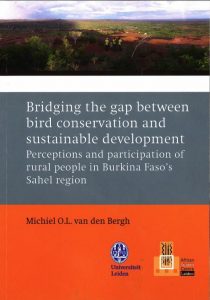Michiel O.L. van den Bergh ~ Bridging The Gap Between Bird Conservation And Sustainable Development. Perceptions And Participation Of Rural People In Burkina Faso’s Sahel Region
 Introduction ~ A (research) project in the Sahel
Introduction ~ A (research) project in the Sahel
The Sahel
The Sahel is a loosely defined and not well demarcated region; it comprises the semi-arid transition region between the Sahara Desert to the north and wetter regions of sub-Saharan Africa to the south (CSELS 2010; UNEP 2007; Agnew & Chappell 1999).[i] The Sahel region is often defined by means of the number of days of the growing season or by the average annual amount of precipitation. Alternatively, the boundaries have also been drawn using latitude and longitude (Agnew & Chappell 1999). However, the boundaries are gradual and arbitrary, changing in time following weather patterns (e.g. droughts), climate changes, and land-use changes and concomitant land-cover changes (Ton Dietz, director ASCL, pers. comm. 2015). Agnew & Chappell (1999: 300) argue that “it is normally taken to be the arid West African countries from Senegal to Chad, but some also include Sudan to the East” (Figure 1.1).
The Sahel region constitutes one major ecoregion[ii] of the African continent (Brito et al. 2014). Different habitats can be found in the region, including large flat plains, gallery forests and sand dunes. The plains are mostly used for grazing and extraction of commodities (i.e. food, medicine, fodder and wood), and some smaller areas are also used for cultivation (increasing in area from north to south in the region) (Lykke et al. 2004). Traditional land-use practices such as nomadic pastoralism and agroforestry, as well as modern forestry rules, are adapted to the arid climate and erratic rainfalls (Zwarts et al. 2009; Mortimore & Adams 2001; Boffa 2000). However, this dynamic equilibrium is in jeopardy from increased agricultural and pastoralist activities, but also from overhunting, unsustainable extraction of natural resources and water overexploitation (irrigation and hydroelectric dams) (Adams et al. 2014; Brito et al. 2014; Zwarts et al. 2009).
Most, if not all, Sahel countries’ economies are strongly dependent on natural resources, but at the same time they are depleting their natural capital, making them exceptionally vulnerable (Cohen et al. 2011). Furthermore, agriculture and animal husbandry in the Sahel are highly vulnerable to climate change (Dietz et al. 2004). The region is home to a population of 100 million, and UN demographic projections for 2050 are 300 million. This rapid population growth coupled with environmental degradation and, at the same time a high dependence on the environment, is cause for grave concern. In 2012, 18 million people in the West African Sahel were suffering from malnutrition (Potts & Graves 2013). Indeed, the Sahel is sometimes labelled as one of the poorest and most environmentally degraded areas on earth (Brandt et al. 2014; CSELS 2010; Lindskog & Tengberg 1994).
The African continent is a winter ground for a quarter of the more than 500 bird species breeding in Europe, which includes between 2 and 5 billion individual birds. Especially the continent’s northern savannas, including the Sahel region, serve as a wintering ground for migrant birds. Indeed, the Sahel is an important area for migrant European birds, both for those species that spend their winter here, and for those species wintering further south on the continent that use this region as a staging area. These migrant birds are highly vulnerable to environmental change in the Sahel (Vickery et al. 2014; Zwarts et al. 2009; Jones 1995). Thus, environmental degradation in the Sahel is threatening the survival of both birds and people (Brandt et al. 2014; Ouédraogo et al. 2014; Cresswell et al. 2007).
Download Book (PDF): https://openaccess.leidenuniv.nl/ASC-075287668-3793-01.pdf
Notes:
[i] “Due to the large contrast in the yearly rainfall, the West African landscape gradually changes from north to south, within a distance of 600-700 km from Sahara desert to humid woodland” (Zwarts et al.2015).
[ii] “Ecoregions are relatively large units of land containing a distinct assemblage of natural communities and species, with boundaries that approximate the original extent of natural communities prior to major land-use change.” (Olson et al. 2001: 933)
ISBN: 978-90-5448-155-3 ~ © Michiel van den Bergh, 2016